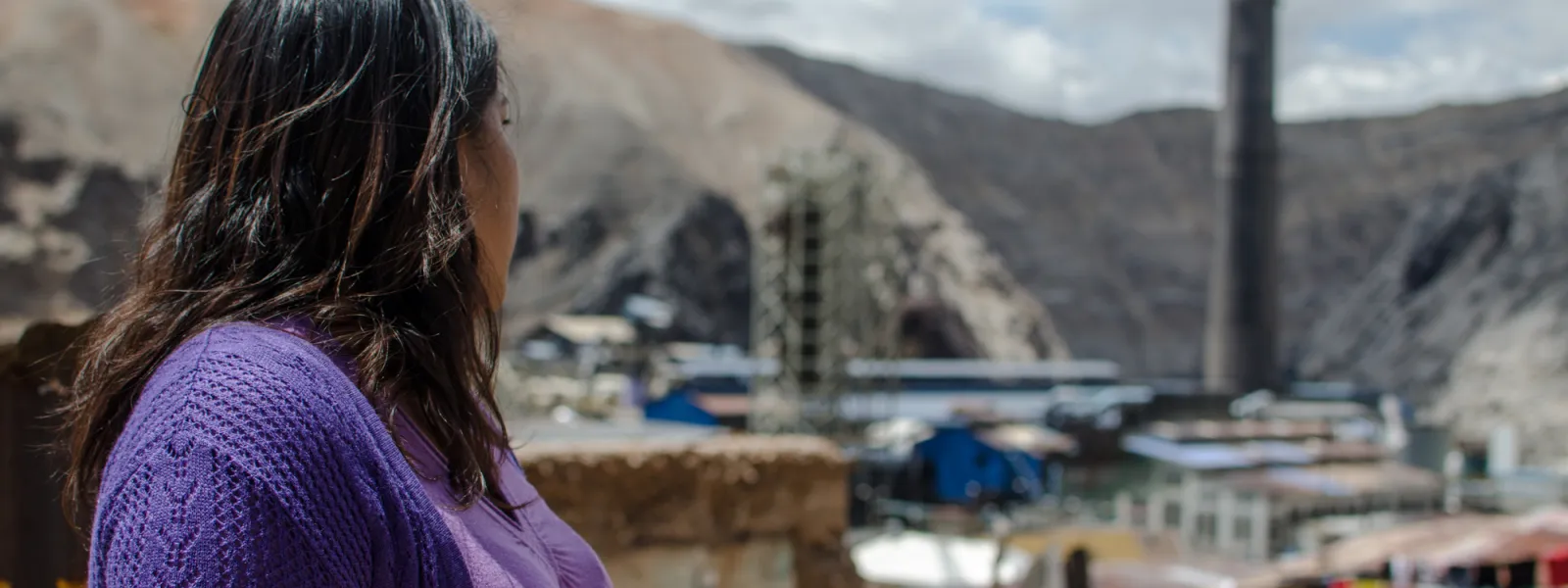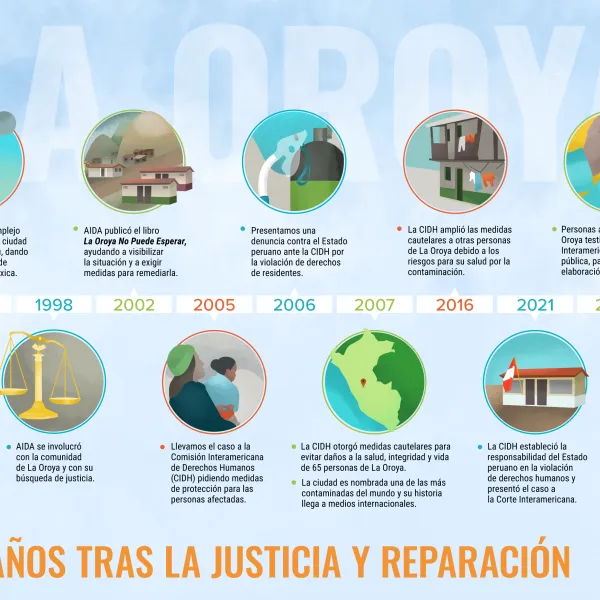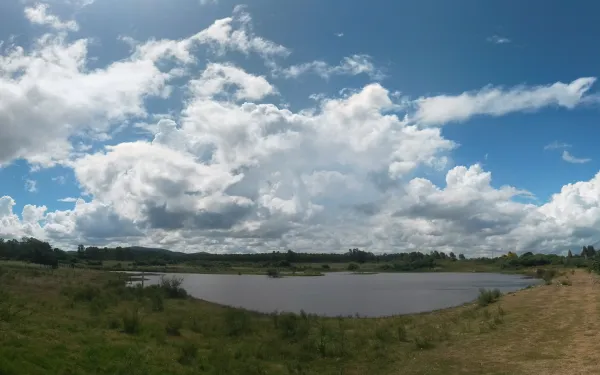
Project
Protecting the health of La Oroya's residents from toxic pollution
For more than 20 years, residents of La Oroya have been seeking justice and reparations after a metallurgical complex caused heavy metal pollution in their community—in violation of their fundamental rights—and the government failed to take adequate measures to protect them.
On March 22, 2024, the Inter-American Court of Human Rights issued its judgment in the case. It found Peru responsible and ordered it to adopt comprehensive reparation measures. This decision is a historic opportunity to restore the rights of the victims, as well as an important precedent for the protection of the right to a healthy environment in Latin America and for adequate state oversight of corporate activities.
Background
La Oroya is a small city in Peru’s central mountain range, in the department of Junín, about 176 km from Lima. It has a population of around 30,000 inhabitants.
There, in 1922, the U.S. company Cerro de Pasco Cooper Corporation installed the La Oroya Metallurgical Complex to process ore concentrates with high levels of lead, copper, zinc, silver and gold, as well as other contaminants such as sulfur, cadmium and arsenic.
The complex was nationalized in 1974 and operated by the State until 1997, when it was acquired by the US Doe Run Company through its subsidiary Doe Run Peru. In 2009, due to the company's financial crisis, the complex's operations were suspended.
Decades of damage to public health
The Peruvian State - due to the lack of adequate control systems, constant supervision, imposition of sanctions and adoption of immediate actions - has allowed the metallurgical complex to generate very high levels of contamination for decades that have seriously affected the health of residents of La Oroya for generations.
Those living in La Oroya have a higher risk or propensity to develop cancer due to historical exposure to heavy metals. While the health effects of toxic contamination are not immediately noticeable, they may be irreversible or become evident over the long term, affecting the population at various levels. Moreover, the impacts have been differentiated —and even more severe— among children, women and the elderly.
Most of the affected people presented lead levels higher than those recommended by the World Health Organization and, in some cases, higher levels of arsenic and cadmium; in addition to stress, anxiety, skin disorders, gastric problems, chronic headaches and respiratory or cardiac problems, among others.
The search for justice
Over time, several actions were brought at the national and international levels to obtain oversight of the metallurgical complex and its impacts, as well as to obtain redress for the violation of the rights of affected people.
AIDA became involved with La Oroya in 1997 and, since then, we’ve employed various strategies to protect public health, the environment and the rights of its inhabitants.
In 2002, our publication La Oroya Cannot Wait helped to make La Oroya's situation visible internationally and demand remedial measures.
That same year, a group of residents of La Oroya filed an enforcement action against the Ministry of Health and the General Directorate of Environmental Health to protect their rights and those of the rest of the population.
In 2006, they obtained a partially favorable decision from the Constitutional Court that ordered protective measures. However, after more than 14 years, no measures were taken to implement the ruling and the highest court did not take action to enforce it.
Given the lack of effective responses at the national level, AIDA —together with an international coalition of organizations— took the case to the Inter-American Commission on Human Rights (IACHR) and in November 2005 requested measures to protect the right to life, personal integrity and health of the people affected. In 2006, we filed a complaint with the IACHR against the Peruvian State for the violation of the human rights of La Oroya residents.
In 2007, in response to the petition, the IACHR granted protection measures to 65 people from La Oroya and in 2016 extended them to another 15.
Current Situation
To date, the protection measures granted by the IACHR are still in effect. Although the State has issued some decisions to somewhat control the company and the levels of contamination in the area, these have not been effective in protecting the rights of the population or in urgently implementing the necessary actions in La Oroya.
Although the levels of lead and other heavy metals in the blood have decreased since the suspension of operations at the complex, this does not imply that the effects of the contamination have disappeared because the metals remain in other parts of the body and their impacts can appear over the years. The State has not carried out a comprehensive diagnosis and follow-up of the people who were highly exposed to heavy metals at La Oroya. There is also a lack of an epidemiological and blood study on children to show the current state of contamination of the population and its comparison with the studies carried out between 1999 and 2005.
The case before the Inter-American Court
As for the international complaint, in October 2021 —15 years after the process began— the IACHR adopted a decision on the merits of the case and submitted it to the Inter-American Court of Human Rights, after establishing the international responsibility of the Peruvian State in the violation of human rights of residents of La Oroya.
The Court heard the case at a public hearing in October 2022. More than a year later, on March 22, 2024, the international court issued its judgment. In its ruling, the first of its kind, it held Peru responsible for violating the rights of the residents of La Oroya and ordered the government to adopt comprehensive reparation measures, including environmental remediation, reduction and mitigation of polluting emissions, air quality monitoring, free and specialized medical care, compensation, and a resettlement plan for the affected people.
Partners:

Related projects
Dams, mines threaten indigenous rights: Recommendations from UN human rights expert
By Jessica Lawrence, Earthjustice's research analyst A longstanding goal of Earthjustice and the Interamerican Association for Environmental Defense (AIDA) has been to sound alarms at the United Nations, in national courtrooms and in international fora such as the Inter-American Commission on Human Rights about environmental and human rights violations associated with mines and dams. Indigenous peoples are particularly vulnerable to the harmful effects of such extractive and energy industries in their territories. Last April, Earthjustice and AIDA provided evidence of these harms, as well as recommendations about how to avoid them, to U.N. indigenous rights expert James Anaya, who recently issued a report on extractive and energy industries and indigenous peoples. Comments from Earthjustice and AIDA focused on mine closure, describing how inadequate closure, restoration or monitoring can cause severe, long-term environmental contamination that can violate indigenous and human rights. We identified steps that countries can take to prevent these problems, including enacting strong laws on pabipty of mine operators and requiring operators to provide financial guarantees to ensure adequate clean-up during and after mine closure. Such measures can help protect human rights to health, clean water and a clean environment, as well as indigenous rights to culture, food, a means of subsistence and their lands and natural resources. Anaya’s report includes a number of recommendations with environmental and health imppcations. Key recommendations include: Guaranteeing indigenous communities’ right to oppose extractive and energy projects without fear of reprisals, violence, or coercive consultations. If a government decides to proceed with a project without their consent, indigenous communities should be able to challenge that decision in court. Rigorous environmental impact assessment should be a precondition. Indigenous communities should have the opportunity to participate in these assessments, and have full access to the information gathered. Governments should ensure the objectivity of impact assessments, either through independent review or by ensuring that assessments are not controlled by the project promoters. Measures to prevent environmental impacts, particularly those that impact health or subsistence, should include monitoring with participation from the pubpc, as well as measures to address project closure. If governments and project operators followed Anaya's recommendations, it would substantially reduce the harm caused to indigenous peoples by the often shameful and irresponsible conduct of extractive and energy industries. AIDA, to which Earthjustice provides significant support, works with local communities to address human rights violations from extractive industries throughout the hemisphere, including the Barro Blanco dam in Panama, the Belo Monte dam in Brazil, the La Parota dam in Mexico, and mines in the Andean ecosystems of Colombia.
Read more
Letter to the President of the World Bank Group
DR. JIM YONG KIM PRESIDENT THE WORLD BANK GROUP Dear Dr. Kim: We are writing to express our deepest concern regarding the World Bank Group decision to start financing and promoting large hydroelectric projects as “sustainable energy.” We urge you to review the information about negative impacts that large dams have had on the environment and human rights in the Americas, and to reconsider that decision. Large dams commonly cause severe harm to the environment. Underwater decomposition of trees and plants releases major quantities of methane, contributing to climate change. Large dams degrade water quality and sanitation both upstream and downstream from the artificial modification of river systems. Degradation of aquatic ecosystems leads to loss of biodiversity. Seismic instability is another common consequence of dam construction. These environmental harms often violate human rights protected by international legal instruments. These projects repeatedly generate health risks, block access to traditional food sources, and interfere with the ability to earn a livelihood. They displace entire communities, interfering with the human rights to freedom of movement, property, housing, and just compensation. State sponsors of large dams routinely fail to produce comprehensive environmental and social impact assessments, which are required by international law. Access to the information that should be provided by such an assessment is essential to ensuring the human rights to informed consent and prior consultation. Specific international laws and standards that apply to indigenous, afro-descendant and tribal peoples are routinely ignored. In some cases, public protest to ill-considered dam projects is criminalized, contrary to international human rights law. Many organizations and institutions, including the World Commission on Dams, have identified these negative consequences. AIDA has also produced a report analyzing the effects of large dams on the environment and human rights, “Large Dams in the Americas.” The executive summary of the report (in English) and the full version (in Spanish) are attached to this letter. AIDA stands with the World Bank Group in supporting development in Latin America. But that development should be sustainable. It should not come at the expense of the environment and human rights. Promotion of truly renewable resources, including wind, solar, and geothermal energy, can also encourage development that sustains growing economies, thriving environments, and respect for human rights. We insist that the World Bank Group finance only projects that abide by international law and standards, and give due and full consideration to alternative energy sources and efficiency measures. We would be more than happy to help the World Bank Group to drive true, sustainable development and to promote projects that increase human well-being while also protecting the environment and human rights. We hope you find this information useful and incorporate it into World Bank policy.
Read moreFrom Anton’s Valley to Altamira: It’s Been a Great Decade with AIDA!
By Astrid Puentes Riaño, AIDA Co-Director , @astridpuentes November 1 marks my 10th anniversary working with AIDA! It’s been a decade since the board of directors, meeting in Anton’s Valley, Panama, decided to hire me. I was thrilled with the offer: when I was a law student in Colombia and an assistant with the NGO Fundepúblico, I had participated in the founding of AIDA and in setting up its first meeting, in 1998. Over the past decade, I have had the great fortune to meet wonderful people and to visit extraordinary places in Latin America— Cordoba in Argentina, Altamira in Brazil, Los Altos de Jalisco and La Parota in Mexico, La Oroya and Iquitos in Peru. Today, as I celebrate and renew my commitment to keep learning and giving my best to AIDA, I am grateful to be able to provide a positive contribution to the region. AIDA was and is my dream job! A big challenge from the beginning When the AIDA board appointed me, it was more for the potential they saw than for my experience. I did my best, contributing my energy and passion to the expansion of environmental law and to promoting an understanding of the link between human rights and the environment, all while raising a family. Ten years later, and thanks to this incredible opportunity, I can say that I have made some mistakes, learned, grown immensely, and come to understand the sometimes-harsh reality of our environment in Latin America. It seems that the board of directors is happy with the results, because I’m still here! How much we have grown! When I started, AIDA was just Anna Cederstav (co-executive director) and me, working with a budget of approximately U.S. $300,000, a small office within the Earthjustice headquarters in California, and four cases. We had many dreams for AIDA. The main goal was to make it a solid regional organization that works on emblematic legal cases, always giving highest priority to the people and communities in the most vulnerable situations, and with about ten lawyers in key countries who stand out for the quality of their work and effective collaboration. Today our team includes 11 attorneys, one scientist, and 10 administrative and communications professionals, based in seven countries. We work every day to promote greater protection and environmental justice and to encourage regional economic development that does not sacrifice our natural resources or our future. Some milestones I’ve been extremely pleased that we’ve helped to improve several areas and communities in the region. For example, we’ve helped achieve: ▪ Official recognition of the environmental and human health disaster in La Oroya, Peru, where the 70-plus people we represent have begun to receive some medical attention from the government; ▪ A significant decrease in the aerial spraying of coca and poppy plants in Colombian national parks; ▪ Protection of leatherback turtles and one of their last remaining nesting sites in Costa Rica; ▪ Increased awareness of the human rights violations suffered by thousands of indigenous people living near the Belo Monte hydroelectric dam in Brazil; ▪ Suspension of a mega-tourism project in Baja California Sur, Mexico that would destroy the Cabo Pulmo Coral Reef, known as the world’s aquarium; ▪ Amendments to the Mexican Constitution to include human rights protections and to improve the recognition of the human right to a healthy environment. In addition, we have published a trilingual guide on how to apply human rights mechanisms to environmental cases; a report on the human rights impacts of climate change in Latin America; and a report on how large dams are not a panacea but instead are having a negative impact on millions of people in our region. We also have organized periodic workshops with our colleagues that emphasize the inseparable link between human rights and the environment. The best aspect of my job over these years has been learning more about the region and every person I have met along the way. In 2004, for example, I took my first trip to La Oroya, where I met Pedro and Juan*, brothers both under 10 years old whom we represent before the Inter-American Commission on Human Rights. With high spirits, they attentively took part in our workshop aimed at protecting their rights, although they nearly fell asleep while eating their soup at lunchtime—one of the effects of lead poisoning. Now teenagers, they have begun their professional careers; Juan is serving in the military, and Pedro in the process of starting the university. Then there are Juanita and Margarita*, who were not yet born in 2004. I got to know the girls during later trips to La Oroya; when I first met them they arrived with their mothers, wrapped in slings. Now they are nearly teenagers and we have developed warm personal relationships that go beyond our legal work with them and with many others. Not everything has been rosy It hasn’t all been happiness and celebration. Over the past 10 years I have sadly witnessed: ▪ Construction of the Baba hydroelectric dam in Ecuador, despite a Constitutional Court ruling that ordered review of the environmental assessment because the project violated constitutional and international laws; ▪ Construction of El Zapotillo Dam in Los Altos de Jalisco, Mexico, although it seems for now that Temaca, a town that authorities had planned to flood, won’t be destroyed; ▪ Start of construction of the huge Belo Monte dam in Brazil, in defiance of the precautionary measures issued by the Inter-American Commission on Human Rights; ▪ Exponential growth in mining projects, including in the Colombian páramos—unique high-altitude ecosystems that provide fresh water for much of the population. What comes next If I weigh the good and the bad, the overall balance is positive. For now, a great part of our dream has become a reality. But just as today’s challenges have become greater, so has my commitment to see through our goals for the region. I extend my sincere thanks to the AIDA board and to Anna, my co-director, as well as to our great team and everyone who has collaborated with AIDA in the past. And I thank my family, friends and our donors, including the foundations and friends who have each managed to donate something, no matter how large or small. Thank you for your generosity and for helping us to fulfill our dreams and change the world together. All of the successes and challenges make the gray hair and wrinkles worth it. I’m ready for many more years at AIDA, as long as I continue to be an effective agent of its success! *Names have been changed to protect the identities of the people mentioned.
Read more